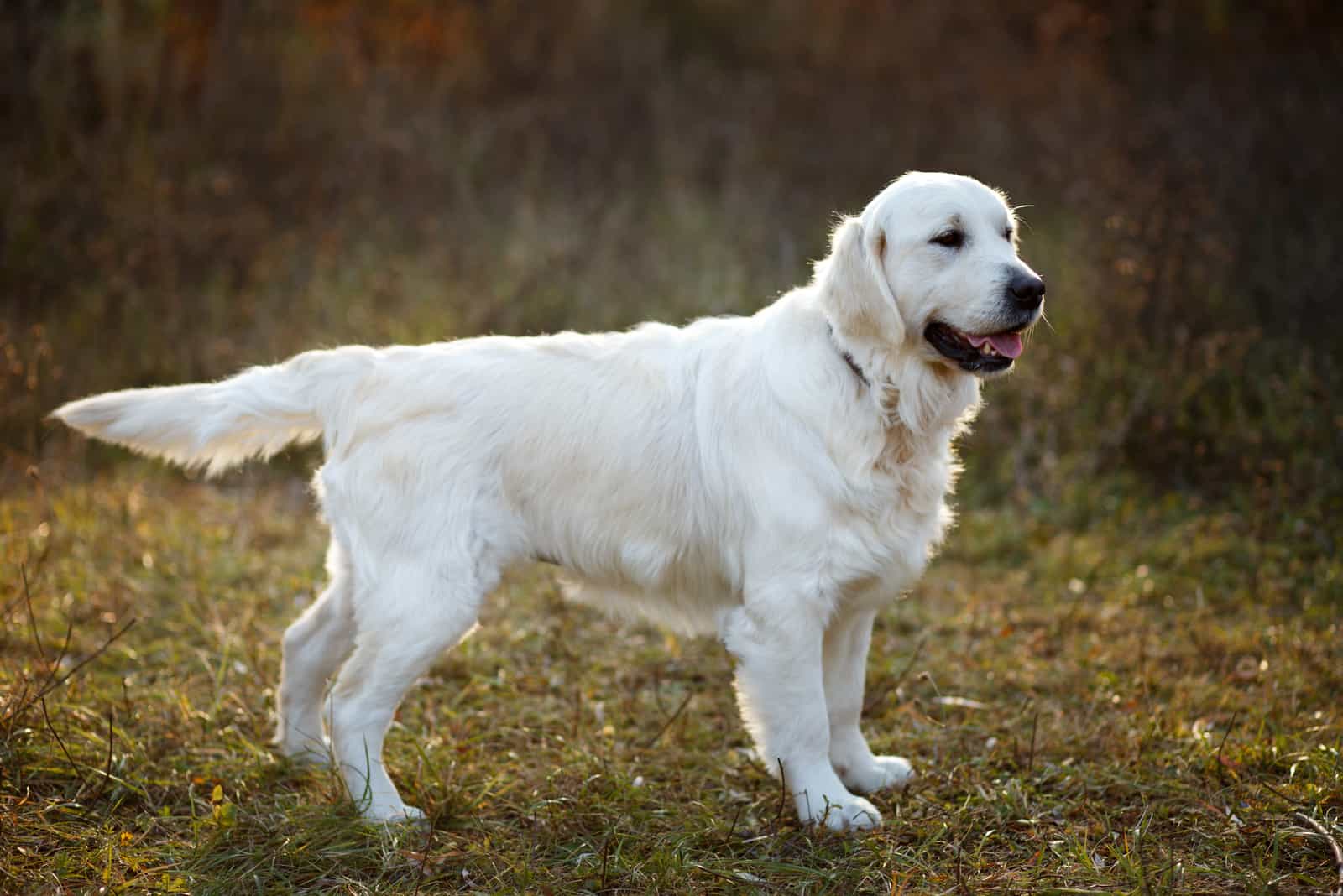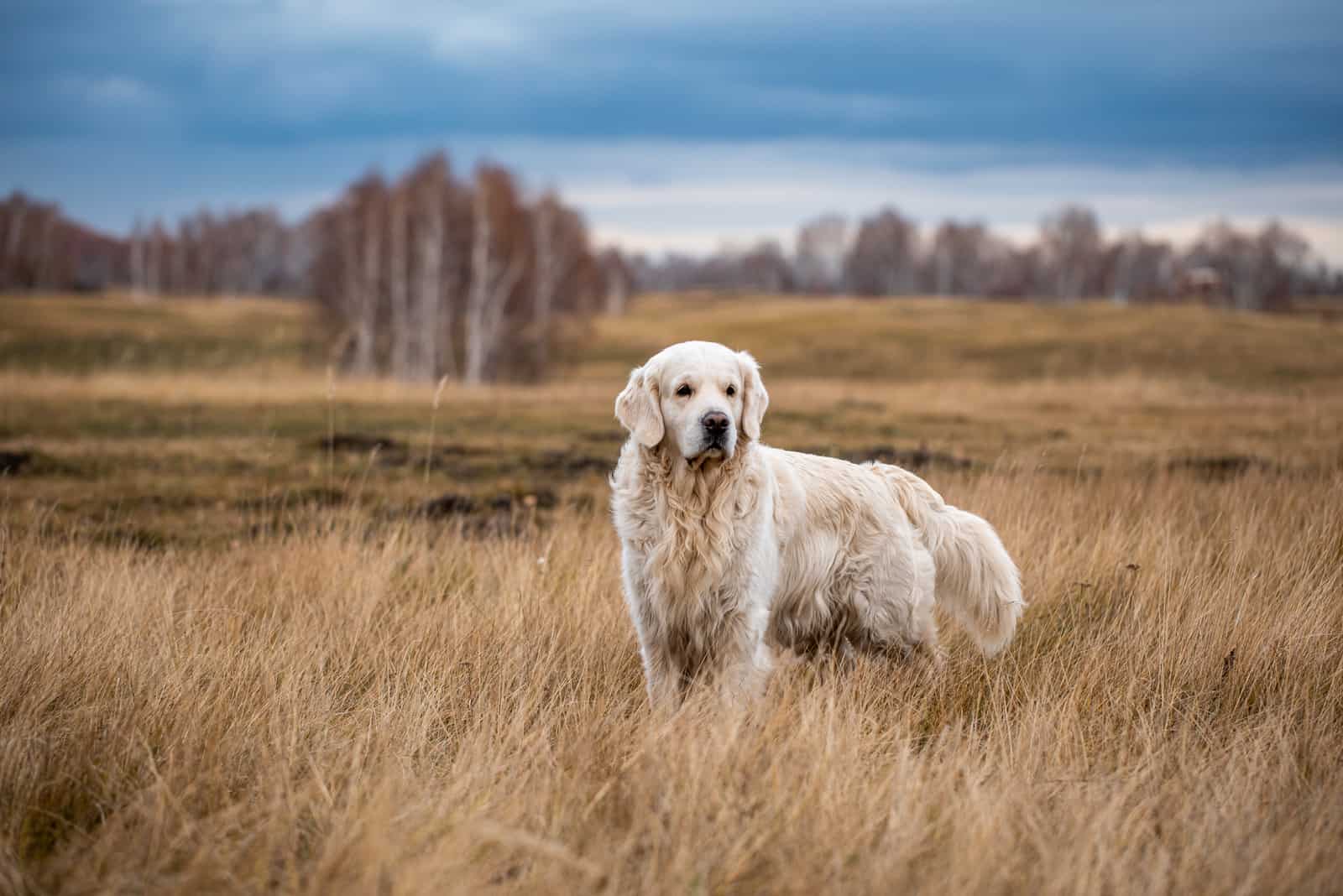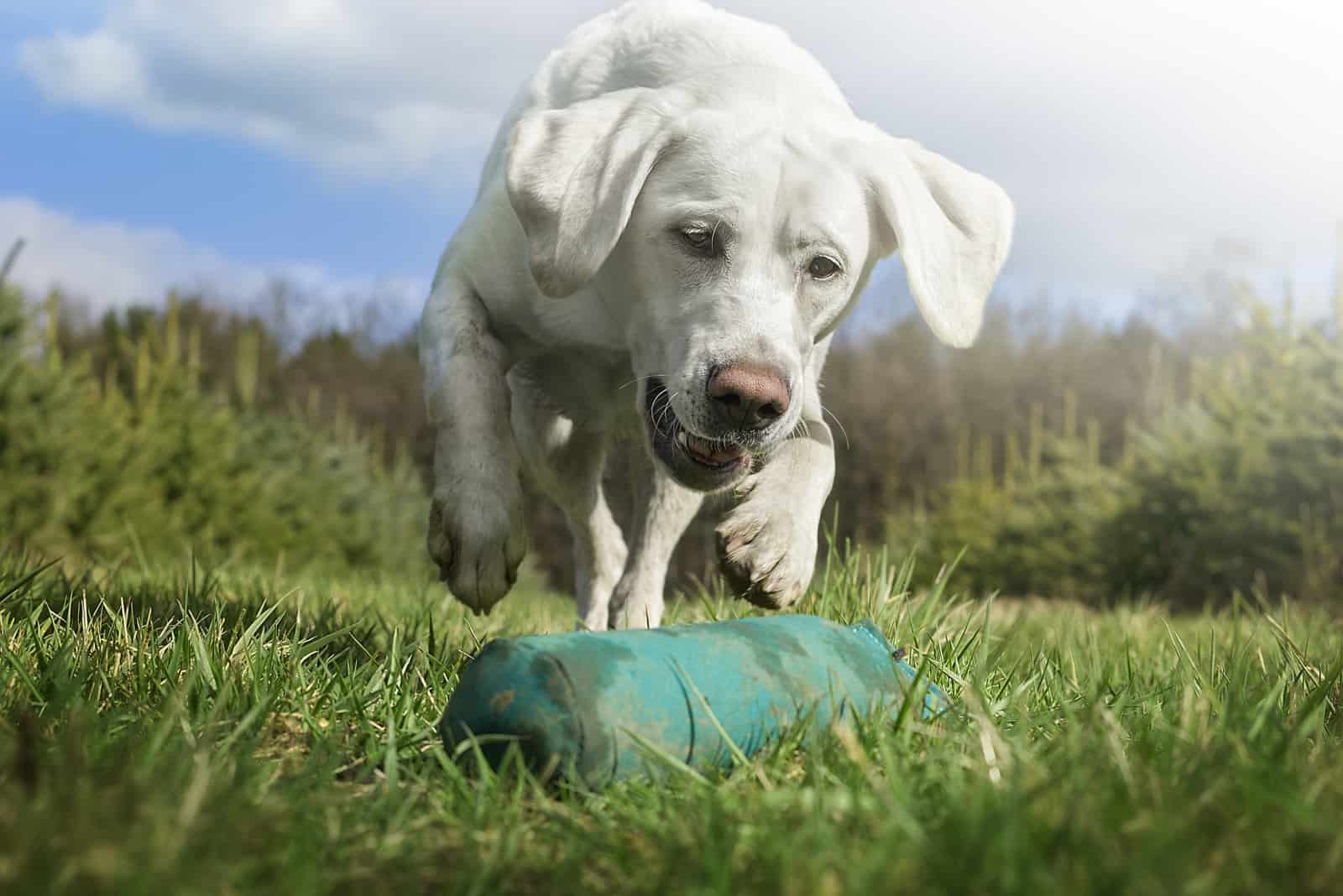The Labrador Retriever is the most popular dog breed in the US and the second most popular in the UK. These golden and chocolate-coated canines make a perfect family companion.
But, what about white Labradors? Are they even a standard purebred Labrador Retriever color, or is this canine a product of some kind of crossbreeding?
When you choose to get a new pet, you’ll probably want to learn as much as you can about it before buying or adopting. Even if it’s just a coat color, you’re likely still curious to know all about these canines.
So, is there any difference between golden and white Labs?
Let’s find out!
Are There White Labrador Retrievers?

That depends on who you ask!
According to the American Kennel Club (AKC), white Labs are recognized as yellow Labradors. This is because white Labradors are, essentially, a very pale version of a standard yellow (or golden) Lab.
This means that, despite their name, white Labradors are no different than yellow ones, even though they look different.
White Labs have very pale, snow-white fur, pigmented noses, and dark eyes. Their fur typically has some touches of yellow or light cream. Don’t see them? Look around your pup’s ears, as this is the usual spot to find darker hairs!
And no, just because a Labrador is white doesn’t necessarily mean that it is a crossbreed. While Labradoodles and other mixes can be white, purebred Labs can come in this colors, as well.
In fact, many dogs can come in white color regardless of albinism. This includes:
• Dobermans
• Bichon Frises
• German Shepherds
• English Bulldogs
The Difference Between A White Coat And Albinism
As these pooches can look perfectly white, some dog lovers wonder if they are, actually, albinos. However, there is a clear set of differences between a white Labrador and an albino Lab. But first, let’s get one thing straight – What is albinism?
Albinism is a genetic condition (sometimes considered a defect) in which the animal or human suffering from it loses melanin and, with it, pigmentation in most or all parts of the body.
Dogs with albinism typically have pale skin, white fur, pink noses, and red eyes.
Besides impacting the way an animal looks, albinism can cause several health issues, such as blindness, an increased risk of cancer, even some neurological problems.
At first glance, it may seem that albino Labradors and white Labradors have the same coat. But, they are not the same. White Labs will have those darker cream patches we mentioned before.
If you want a clearer distinction, look at a dog’s nose and the skin around its eyes. If these areas are dark, the dog isn’t an albino. However, if they are pink, then yes, the pup most likely has albinism.
Leucistic White Labradors

Now, let’s talk about leucistic white Labradors. These Labs are different from both standard white Labs and albinos.
Leucistic means ‘low pigment,’ and this on its own explains quite a bit about these Labs.
Unlike albinos, which can’t produce pigment, in leucistic white Labradors, the relevant cells are blocked from migrating to the location where pigment is needed.
This condition is similar to vitiligo in humans in that it can affect either the entirety of a dog’s fur and skin or just certain parts.
While sometimes it can be hard to distinguish these dogs from albino ones, you can once again look at a dog’s eyes, as these are typically unaffected and remain dark.
This is a rare condition, as it is inherited via recessive genes.
Just like albinism, leucism comes with the same health concerns. The area without the pigment can be easily damaged by the sun, so these dogs have higher chances of developing some forms of cancer.
However, as their eyes remain healthy, this is one less concern.
Genetics

Photo from @hank.the.white.lab_
Typically, Labradors come in three coat colors: yellow, chocolate, and black. Some people might not be aware that these colors come in plenty of shades and variations.
For example, black Labs can be anywhere between jet black and brownish-black. Some might even have hints of gray! Similarly, chocolate Labs range from dark chocolate to milky coffee variations.
In the same way, yellow Labs can look anywhere between fox red and gold to an almost pure white – and this is where white Labs come in.
Some of these differences go beyond the coat color and pigment. For example, there are two kinds of Labradors, both with different genetics – the English Labrador and the American Labrador.
Both types are retrievers and originate from the same dog breed – but they look slightly different, especially if you look at how they are built.
English Labs are typically considered ‘show dogs,’ while the American variation is more of a ‘working dog.’
Compared to the American variant, the English Lab has shorter legs, broader shoulders, a slimmer neck but a wider head, a fuller face, and a straight tail. Even the coat of the English Lab is much thicker than the American Lab.
Also, some dog owners reported that there are differences in temperament. The English Labrador is, supposedly, much calmer and friendlier than its American counterpart.
Of course, both types of Labrador dogs make amazing companions, and the coat color doesn’t change that. In the end, all Labradors are friendly, loyal, and playful family pets.
See Also: 11 Amazing Chocolate Lab Breeders From All Over The USA!
Phenotype And Genotype

When you look at your pup, describing the color of its fur seems pretty straightforward. For example, your pooch has a yellow coat, brown eyes, and dark nose – or any other combination.
However, to understand the difference between the shades, it’s important to know that genetics aren’t as simple as black and white. Behind the scenes, things get a lot more complicated.
Your pooch’s appearance – whether that be a white Labrador or any other dog breed – is called his ‘phenotype.’ This is what’s on the outside.
Phenotype is the result of genotype – the genes that your pet inherited from his parents that worked together to create what you see on the outside.
Despite the numerous coat colors you can see in dogs, all of this is determined by only two basic color pigments – eumelanin and phaeomelanin.
Eumelanin is responsible for the black and brown pigment, while phaeomelanin creates a yellow and red pigment.
Depending on the combination of these two pigments – or the absence of any or both of them – you’ll get any fur color available. Sure, there are plenty of other genes that affect the overall appearance, but they simply determine how these pigments will be spread.
The Silver Labrador
White Labs can often be confused with silver Labradors, but they are not the same.
Silver Labrador Retrievers are the result of a dilution of the pigment of brown or black dogs.
Unlike white Labradors, which are recognized by the kennel club and accepted in various dog shows, there is quite a bit of controversy regarding silver Labradors. Many consider them to be a ‘catastrophe’ for the breed due to their faulty genetics.
Even if you manage to register your silver pup (you’d have to do it under the ‘chocolate Labrador Retriever’ label), these dogs aren’t accepted in dog shows and can be difficult to breed legally in some countries.
However, just like yellow Labradors with a white coat, this silver variety is entirely natural, and most of these dogs don’t have any defects and health concerns. Their personality is the same as that of other Labs, and they make equally good pets.
Labrador Origins

The Labrador Retriever breed originates from Newfoundland. Their name comes from the Labrador Sea that surrounds Newfoundland’s coasts.
In the 16th century, the Newfoundland settlers worked mostly as fishers. As they already had dogs as companions, they decided to breed them to match their daily lives and become their helpers.
To do so, the villagers began breeding native dogs from Newfoundland with other breeds, trying to create dogs with shorter hair and more compact bodies. They began calling these pups ‘water dogs,’ as they would help fishermen catch and retrieve crab traps and fish from the water.
Another reason behind this nickname is because these dogs were excellent swimmers. So, if you’ve wondered why Labs love water so much – the reason lies in their origins.
These new dogs were loyal, intelligent, and always eager to please their masters and help them with their tasks. Eventually, because of the work they did, people began calling them ‘Retrievers.’
As time passed, hunters began using these dogs instead of other hunting breeds. Over time, Labs became known as hunting dogs and gun dogs before they moved into the comfort of our homes, and the rest is history.
Are White Labradors Rare?

Yes, white Labradors are among the rarest types of Labradors.
Pale yellow Labs are very rare, and they can be somewhat difficult to breed. With such mild shade differences, there is no guarantee all puppies from a white Labrador litter will inherit such a pale coat color. This is why there aren’t many white Labrador breeders out there.
Albinism is very rare in dogs, just like leucism. It is assumed that no more than one Lab in every 20,000 is affected by albinism.
All of this makes it easy to see why white Labs are so sought after and beloved in the Labrador-lover communities.
Are White Labs Purebred?

Yes, white Labradors are entirely purebred dogs as the genetics for such a pale color exist in their breed. So, just because a Labrador puppy is paler than you’re used to doesn’t mean they aren’t purebred.
You can register white Labradors (but not albino ones) with the AKC, and they can even participate in shows under the title of yellow Labradors.
Coat Color Changes

Just because your white Lab’s coat color has changed doesn’t mean that there is something wrong with it! Since the color of their coat results from simple genetics, it can change a bit after sun exposure, just like human hair.
However, while human hair typically becomes lighter in the sun, a white Lab’s coat can become more yellow over time. This is entirely normal, and it doesn’t mean there is anything wrong with your pup or its fur.
Labradors have a double coat which also means that there can be a minor shade difference between the upper coat and the undercoat. So, if you’re brushing your yellow Labrador but noticing white hairs, chances are its undercoat is simply lighter than the rest of its fur.
And, as we’ve mentioned before, some parts of the white Lab’s coat are more prone to becoming darker as time goes on. This is perfectly normal, and there is no need to be concerned.
Not just that, but many white Labrador puppies can turn darker in color as they grow older. It isn’t uncommon for pups to be almost pure white right after birth, just to become darker after the first few months.
In other words, just because a Labrador was born white doesn’t mean it’ll stay that way!
If you want to learn about another dog breed that tends to change colors (all colors, not just white!), you can read more about them here!
Do White Labradors Shed?

All Labradors have double coats that are very prone to shedding. The color doesn’t matter – be prepared for some serious grooming! They’ll need daily brushing, and even then, you’ll likely find hairs everywhere!
Fortunately, if you adapt yourself to a daily grooming and vacuuming routine, maintaining your Lab shouldn’t be too difficult a task.
Another helpful tip is to buy upholstery in light colors. White hairs won’t be visible on white, cream, or grey furniture, so you won’t need to clean every single day.
Unfortunately, this also means that white Labrador Retrievers are in no way hypoallergenic. If you’re looking for a dog that will be suitable for your dog allergies, it would be best to skip Labradors altogether.
White Lab Eye Color

We’ll go a bit more in-depth about the eye color of white labs and what they mean for these beautiful dogs.
Eye color develops independently of cellular migration, which is responsible for producing pigments in the coat. For example, two red Labs might have the same coat shade but an entirely different eyeshade (although it will still be a shade of brown).
Similarly, leucistic Labs will also have regular, brown eyes, as leucism affects only pigments on the dog’s skin. However, albinism affects the entire body, so these dogs will have blue or red eyes.
A regular American or English white Labrador is simply a yellow Lab with a pale coat color. This is simply a different way the yellow color is expressed, just like there are many different shades of all other colors.
The same goes for a Labrador’s skin. If you have a standard white Labrador Retriever puppy, chances are he has dark rims of the eyes, a black nose, and brown eyes.
However, even if the nose color is somewhat lighter, this doesn’t immediately mean your Labrador isn’t purebred or has hidden albinism or leucism. There are Labs of every color with brighter skin, and this is entirely normal.
Temperament And Health

Many people looking to get a white Lab puppy for the first time wonder if their new best friend would behave any differently from regular Labrador Retrievers.
To date, there is no evidence that there is any difference in health or behavior in Labradors of any standard coat color.
In nature, a pure white coat is typically a disadvantage, as it makes the animal more visible to the predators – with the exception of animals living in snowy environments, such as polar bears or snow foxes.
However, with domestic animals, a white coat is usually an advantage, as people fall in love with white pups and kitties! The same goes for white Labradors.
The only issue that can come with white Labradors is that their pale coat and skin make them a bit more sensitive to sunlight. This only worsens in the case of dogs suffering from albinism or leucism.
However, if you want to ensure your Lab is ‘up to standards,’ you need to choose a reputable breeder. This will ensure that you get not only a healthy dog but also a well-behaved one.
Responsible dog breeders always test all of their dogs (including all available puppies) to ensure no one has any genetic health problems. Dogs that aren’t healthy shouldn’t be bred, as this encourages the spread of bad genes.
Other than DNA testing, always ask to meet both parents of your future puppy. Look at their behavior. Chances are the puppies from their litter have inherited their temperaments from one of their parents, or a combination of them both.
All Labrador Retrievers are friendly, people-loving dogs who thrive in a family environment. They’ll love being surrounded by humans, even little kids, and they make great family pets.
However, just to stay on the safe side, always ask your vet to do a wellness exam before you make that big commitment. You don’t want to get a dog just to end up abandoning it a few months later.
And keep in mind that even blind or deaf Labs still make amazing family pets, as long as you invest extra time in training and teaching alternative functioning methods.
If you want to make sure your white Labrador stays in good health, you should make sure you give him plenty of exercise and good food. Even healthy dogs can become sick if they are obese or eat unhealthy.
A good idea would be to replace store-bought snacks with healthy alternatives from your kitchen. Instead of typical treats, try using carrots, paprikas, or Brussels sprouts. Your Labs might love it!
Find more useful information in our Labrador feeding chart.
Can Black Labs Have White Markings?

It isn’t unusual for black Labradors to have a white mark on their chest. This pattern makes many people confuse them with the St. John’s Water Dog – a breed that is, in fact, one of the ancestors of the Labrador breed.
Labradors of any color can have white markings, and this isn’t a rare occurrence. This only means that certain alleles (in this case, genes determining the exact coat color) exist in the dog’s genetics.
White markings don’t indicate your black Lab has any potential health problems. This also doesn’t mean your dog isn’t purebred, and these dogs can still be registered with all kennel clubs.
However, white markings might prevent you from listing your pup as a show dog.
How Much Does A White Labrador Cost?

Since white Labradors are so rare, many dog lovers think they are expensive.
Regular purebred Labradors cost anywhere between $300 and $3,000, depending on the location, bloodlines, and the breeder’s reputation.
Remember, white Labradors are pale yellow Labradors, which is considered a standard color. They shouldn’t cost more than any other pup from a litter – but this isn’t always the case.
If the breeder exclusively breeds white Labradors, the pups can be closer to the higher end of the price range. People love unusual pets, and white Labs are one of them.
Pups with albinism or leucism are a whole different story.
Despite the many health issues that come with puppies with these conditions, albino animals have become incredibly popular in the past few years. As a result, this means that puppies with albinism can cost more than regular, healthy dogs.
While the morality behind this is up for debate, if you’re looking for an albino puppy, be prepared to pay several thousands of dollars for it – and a few hundreds more for all the vet bills that will follow so you can know just how much care your future pet will need.
Read Next:
• 11 Labrador Breeders In Texas That You Can Trust
• Charcoal Lab: Unique Labrador Retriever Color
• 9 Labrador Breeders In New York That You Can Trust
















